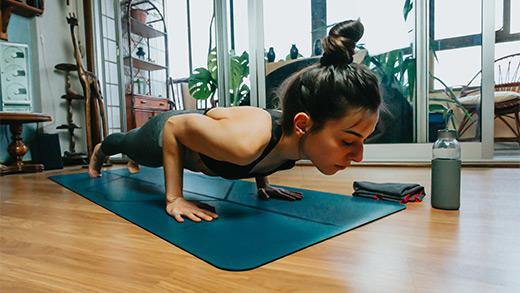The perfect yoga practice for YOU
There are so many different types of yoga out there, you can practice yoga whether you want a physically demanding class, one that requires great concentration and precise movements, or a gentle, relaxing, or meditative class. And whether you are new to yoga, returning after many years, or have a well established practice (yet want to explore new directions) find out what it means to make your practice your very own.
The question is, should you commit wholly to one style of yoga, or spread your energies amongst many styles? The answer is different for each person. There are certainly benefits to sticking with one style of yoga. There is also validity to being open to a variety of experiences; learning to indulge in many tastes, styles, and approaches. If one day you want to sweat and strengthen your way through a Power class and the next day you feel more like being guided by your Yin teacher into a long, deep Pigeon Pose, you can choose that. Varying your practice can be a way to get in touch with your inner guidance, foster balance in your body, and bring a quality of richness and spaciousness to your yoga.
So how do you decide?
Listen to your body, and then acknowledge your mental, emotional and spiritual needs as well. With so many disciplines, each style is a bit different from the others. You'll find variations depending on the teacher too, so giving a few styles and teachers a try before choosing your favorites will enhance your overall yoga experience and challenge you to break out of your comfort zone.
When it was first conceived over 1,000 years ago the sole purpose of practicing yoga was to experience spiritual enlightenment. As a relatively recent phenomenon, Western yoga began to boom in the United States a little more than half a century ago, becoming a fixture on the wellness scene. Over the intervening years, classical forms have been adapted to be more fitness-focused — and sometimes plain gimmicky. Now there are so many options, it can be difficult to keep up. You may be wondering: Why take hot yoga when I sweat enough in a power yoga class? How does ashtanga compare with Iyengar? Does aerial yoga require experience as an acrobat? Does having a goat, dog or kitten – or any other animal in class really enhance my experience? Read on to see what defines 10 popular styles, and how they differ from each other.
1. HATHA often tops the lists of class offerings- both online and in studios. It is probably what comes to mind when most people think of yoga. In America, almost every yoga class is, technically, hatha as the term "hatha" is a generic designation for any form of yoga focused on movement. However, classes named “hatha” generally focus on basic postures, such as downward-facing dog or the warrior poses. Sometimes the poses are combined into a set or series — for example, sun salutations — with each pose held for several breaths. Breathing is also rhythmic, with inhaling and exhaling as drivers of motion, as well as a way to find stillness.
3. ASHTANGA is similar to vinyasa — you’ll flow from one pose to the next and be guided by your instructor to link your breath to the movement of your body — but the difference is that it’s always the same poses, in the same progression. Vinyasa yoga stems from ashtanga as the flowing style linking breath to movement. Expect a good workout; you’ll challenge yourself and get sweaty. These classes really work your core and breathing with fast-moving, invigorating postures and breath exercises. Ashtanga yoga involves a very physically demanding sequence of postures, so this style of yoga is definitely not for the beginner. It's expected of you to know the series. It takes an experienced yogi to really love it.
4. For some, Ashtanga may seem unapproachable. In 1995, Bender Birch set out to challenge Americans' understanding of what it really means to be fit with her book POWER YOGA. Bender Birch's intention was to give a Western spin to the practice of Ashtanga Yoga, a challenging and disciplined series of poses designed to create heat and energy flow. "Most people wouldn't take a class called Ashtanga Yoga, because they had no idea what it meant. Power Yoga, on the other hand, was something Americans could relate to and know that they'd get a good workout," says Bender Birch. Power Yoga's popularity has spread to health clubs across the country and has taken on a broad range of applications. The common thread is a rigorous workout that develops strength and flexibility while keeping students on the move.
5. Is it hot in here? There are different styles of yoga designed to make you sweat. Bikram is highly regimented and consists of 26 postures, mostly done twice in a row, in a hot, humid room where temperatures can exceed 100 degrees. Because the series never changes, it’s good for beginners as well as advanced practitioners, unless they’re the type of people who get easily bored. HOT YOGA, on the other hand, is derived from Bikram but is flexible in format. It just means the room is warm — typically between 80 and 100 degrees — and might contain any range of postures or particular series. The idea is that the heat helps protect your muscles from injury while also allowing you to deepen the poses. Classes might look different depending on where you’re practicing. In a heated class, a teacher will probably remind students that, if they start to feel lightheaded, they always have the option to lie down on the mat. However, people with conditions including cardiovascular disease, back pain, asthma, diabetes, low blood pressure or pregnancy should consult with a doctor before trying this practice.
6. IYENGAR YOGA, pronounced eye-yen-gar, was developed by the esteemed teacher BKS Iyengar in the 1970s. This practice is regimented, form-focused and prop-centric. (Yoga props, or tools that help you modify poses or support your body, include blocks, straps, bolsters and blankets, among other items.) It has within its defined tradition both very vigorous and very gentle sequences. There are hundreds of different sequences, so there is a lot of variety among classes, and it can be practiced by students at all stages. Poses are held for various lengths of time and do not flow from one to the next. The goal is to achieve proper alignment, as well as build strength and balance. This is a good style to explore if you’re trying to truly understand postures from the inside out.
7. YIN YOGA is a slow-paced style of yoga with seated postures that are held for longer periods of time. You spend more time in fewer postures throughout the class. Like Iyengar, many props are used and are placed just right such as blankets, blocks and bolsters. All of the props are there to help you sink deeper into the poses and actually increase gravitational pull to deepen the stretch. Students are encouraged to explore the “edge” of a stretch and go beyond perceived limitations by staying in postures for one to five minutes. While the slow pace may seem relaxing to the observer, it is where real work is happening. If you’re looking for a practice that will help support you during other styles of yoga, and you’re patient enough to stay in a posture for long periods of time, then yin might be for you. In these classes, the instructor will have you hold a posture for several minutes, which helps connective tissue such as tendons, ligaments and fascia become more flexible. A long half-pigeon pose can be painful in the moment. But your body will thank you the next time you’re holding Warrior II.
8. While often lumped into the same category as Yin, RESTORATIVE YOGA by contrast focuses on winding down and fully relaxing your mind and body. At its core, this style focuses on total relaxation. Restorative Yoga is not about stretching, it’s about opening. It also uses props, but with the intention of decreasing gravitational pull by fully supporting the body for a full release of the muscles. Students are meant to find comfort and ease, not push to the edges. Restorative poses demand ample support for comfort during the long hold times. Resting in a pose for 20 minutes or longer is a core part of the practice, although some poses are held for less time. The point of a restorative class is to take students to a place of uninterrupted rest so that the senses can turn inward—only then can the parasympathetic nervous system do its healing work. Longer holds in supported positions give our system the chance to switch gears from the sympathetic (fight or flight) to the parasympathetic (rest and digest) nervous system. Once our parasympathetic nervous system is working, our ability to heal the body in all ways begins to unfold.
9. AERIAL YOGA. If there is a part of you that regrets never running off to join the circus, aerial yoga, a style that can be found in specialty studios, offers you the opportunity to feel like you’re swinging from a flying trapeze (or at least being suspended in midair). With its goal of stretching, aerial yoga adds elements of Pilates and dance to traditional yoga poses, supplemented with a hammock so that practitioners can hold the postures while hanging in the air. It can, with the aid of gravity, help students deepen poses that might be more difficult on the ground. Even so, it may not be right for everyone. Pregnant women, and anyone with an injury or medical condition, should consult a health professional before pursuing this practice.
10. BOUTIQUE YOGA STYLES. As yoga becomes an increasingly popular form of exercise in the United States, boutique studios and fitness companies are coming up with new styles. Paddleboard yoga is one emerging form, for example. Balancing adds an extra challenge, and you might wind up in the water. Some styles probably aren’t going to make it into your regular rotation. But who knows, getting into downward dog with a goat balancing atop your back might be a charming way to enhance your practice.
You may find that, after several years of experimentation, one method really captures you. You may decide to give yourself to it completely. Or, you may dedicate yourself to a particular system, but as your circumstances (such as age, health, or energy level) change, you may find that you are drawn to other styles.
No one can decide the right way for anyone else. As long as you take your physical capabilities into account, and practice in a way that is safe for your body, you will foster a long and satisfying relationship with your mat. Yoga is fundamentally a deeply personal practice; no one system or approach is better or worse than any other. If you are growing through your yoga and love doing it, then it's working.
If you've enjoyed this post, please let us know, we love to hear from you! As always we strive to offer products that introduce the symbols central to yoga culture. Please shop our apparel, eco-friendly yoga mats, jewelry and even block and wheel props to enhance your practice!


